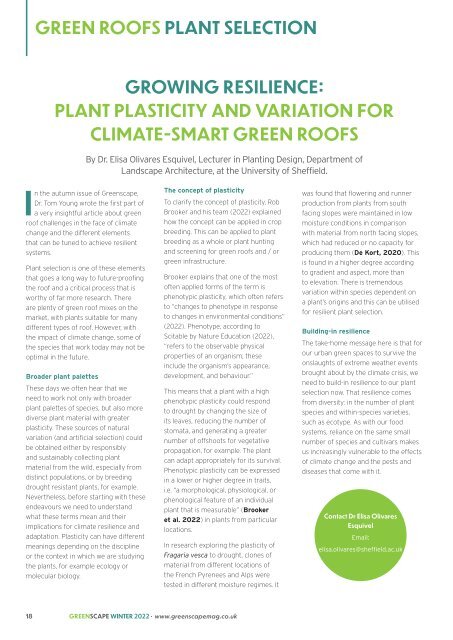Winter 2022
You also want an ePaper? Increase the reach of your titles
YUMPU automatically turns print PDFs into web optimized ePapers that Google loves.
GREEN ROOFS PLANT SELECTION<br />
GROWING RESILIENCE:<br />
PLANT PLASTICITY AND VARIATION FOR<br />
CLIMATE-SMART GREEN ROOFS<br />
By Dr. Elisa Olivares Esquivel, Lecturer in Planting Design, Department of<br />
Landscape Architecture, at the University of Sheffield.<br />
In the autumn issue of Greenscape,<br />
Dr. Tom Young wrote the first part of<br />
a very insightful article about green<br />
roof challenges in the face of climate<br />
change and the different elements<br />
that can be tuned to achieve resilient<br />
systems.<br />
Plant selection is one of these elements<br />
that goes a long way to future-proofing<br />
the roof and a critical process that is<br />
worthy of far more research. There<br />
are plenty of green roof mixes on the<br />
market, with plants suitable for many<br />
different types of roof. However, with<br />
the impact of climate change, some of<br />
the species that work today may not be<br />
optimal in the future.<br />
Broader plant palettes<br />
These days we often hear that we<br />
need to work not only with broader<br />
plant palettes of species, but also more<br />
diverse plant material with greater<br />
plasticity. These sources of natural<br />
variation (and artificial selection) could<br />
be obtained either by responsibly<br />
and sustainably collecting plant<br />
material from the wild, especially from<br />
distinct populations, or by breeding<br />
drought resistant plants, for example.<br />
Nevertheless, before starting with these<br />
endeavours we need to understand<br />
what these terms mean and their<br />
implications for climate resilience and<br />
adaptation. Plasticity can have different<br />
meanings depending on the discipline<br />
or the context in which we are studying<br />
the plants, for example ecology or<br />
molecular biology.<br />
The concept of plasticity<br />
To clarify the concept of plasticity, Rob<br />
Brooker and his team (<strong>2022</strong>) explained<br />
how the concept can be applied in crop<br />
breeding. This can be applied to plant<br />
breeding as a whole or plant hunting<br />
and screening for green roofs and / or<br />
green infrastructure.<br />
Brooker explains that one of the most<br />
often applied forms of the term is<br />
phenotypic plasticity, which often refers<br />
to “changes to phenotype in response<br />
to changes in environmental conditions”<br />
(<strong>2022</strong>). Phenotype, according to<br />
Scitable by Nature Education (<strong>2022</strong>),<br />
“refers to the observable physical<br />
properties of an organism; these<br />
include the organism’s appearance,<br />
development, and behaviour.”<br />
This means that a plant with a high<br />
phenotypic plasticity could respond<br />
to drought by changing the size of<br />
its leaves, reducing the number of<br />
stomata, and generating a greater<br />
number of offshoots for vegetative<br />
propagation, for example. The plant<br />
can adapt appropriately for its survival.<br />
Phenotypic plasticity can be expressed<br />
in a lower or higher degree in traits,<br />
i.e. “a morphological, physiological, or<br />
phenological feature of an individual<br />
plant that is measurable” (Brooker<br />
et al. <strong>2022</strong>) in plants from particular<br />
locations.<br />
In research exploring the plasticity of<br />
Fragaria vesca to drought, clones of<br />
material from different locations of<br />
the French Pyrenees and Alps were<br />
tested in different moisture regimes. It<br />
was found that flowering and runner<br />
production from plants from south<br />
facing slopes were maintained in low<br />
moisture conditions in comparison<br />
with material from north facing slopes,<br />
which had reduced or no capacity for<br />
producing them (De Kort, 2020). This<br />
is found in a higher degree according<br />
to gradient and aspect, more than<br />
to elevation. There is tremendous<br />
variation within species dependent on<br />
a plant’s origins and this can be utilised<br />
for resilient plant selection.<br />
Building-in resilience<br />
The take-home message here is that for<br />
our urban green spaces to survive the<br />
onslaughts of extreme weather events<br />
brought about by the climate crisis, we<br />
need to build-in resilience to our plant<br />
selection now. That resilience comes<br />
from diversity: in the number of plant<br />
species and within-species varieties,<br />
such as ecotype. As with our food<br />
systems, reliance on the same small<br />
number of species and cultivars makes<br />
us increasingly vulnerable to the effects<br />
of climate change and the pests and<br />
diseases that come with it.<br />
Contact Dr Elisa Olivares<br />
Esquivel<br />
Email:<br />
elisa.olivares@sheffield.ac.uk<br />
18 GREENSCAPE WINTER <strong>2022</strong> • www.greenscapemag.co.uk

















